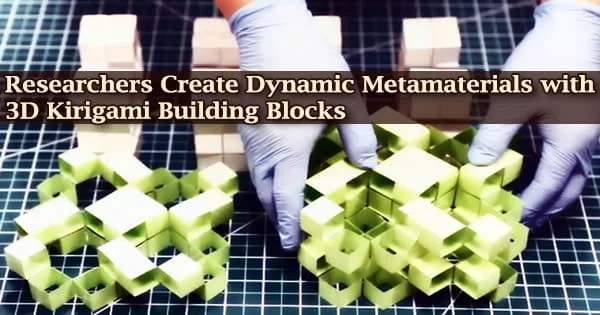A novel method of making metamaterials uses kirigami techniques to construct three-dimensional, reconfigurable building blocks that can be utilized to form complex, dynamic structures. These constructions are simple to assemble and deconstruct thanks to the modular design concept.
“Applying kirigami to three-dimensional materials offers a new level of reconfigurability for these structures,” says Jie Yin, corresponding author of a paper on the work and an associate professor of mechanical and aerospace engineering at North Carolina State University.
These 3D metamaterials could be employed in applications such as lightweight building materials, modular robotics components, and wave guiding in acoustic metamaterials, according to the researchers.
Kirigami is an origami variation in which the paper is cut as well as folded. Yin and his associates have applied the concepts of kirigami to three-dimensional materials that are sliced into connected cubes, rather than utilizing two-dimensional materials like paper.
The researchers used a set of eight connected cardboard cubes that are open on two sides to represent their innovative approach. Each unit of eight connected cubes can be thought of as a building block. These building pieces may be folded into over 300,000 distinct configurations depending on how the cubes are joined to each other.
The fact that you can disassemble and reconfigure these 3D metamaterials allow users to alter the mechanical properties of a structure as needed to perform different tasks. Fold it one way to make it easy to compress, fold it another way to allow for lateral movement, fold it a third way to make it rigid or enhance its physical strength, and so on.
Jie Yin
“Think of these kirigami units as versatile building blocks that can be assembled to create larger structures with different mechanical properties,” Yin says.
“What’s more, the larger structures can also be disassembled, allowing users to reassemble the kirigami units into new structures.”
The researchers constructed more than a dozen reconfigurable building components to demonstrate the concept’s potential. Each block was made up of eight paper cubes that could be rearranged into eight distinct shapes.
The video shows how each unit can be reconfigured into various structures, how those structures can be joined into larger structures, and how the larger constructions can be disassembled back into the reconfigurable blocks.
The structure will react differently depending on the orientation of the solid cube walls and open sides in each block, as well as the placement of each block in the bigger structure. This allows users to fine-tune the mechanical qualities of each building block.
A single construction block, for example, may be folded into a compressible structure or refolded into a new shape capable of sustaining a considerable load.
“The fact that you can disassemble and reconfigure these 3D metamaterials allow users to alter the mechanical properties of a structure as needed to perform different tasks,” Yin says. “Fold it one way to make it easy to compress, fold it another way to allow for lateral movement, fold it a third way to make it rigid or enhance its physical strength, and so on.”
“This work was focused on demonstrating the fundamental concept,” Yin says. “Our next step is to demonstrate applications for the concept.”
Advanced Functional Materials published the work “3D Transformable Modular Kirigami-Based Programmable Metamaterials.” Yanbin Li, a Ph.D. student at NC State, is the paper’s first author.
The paper was co-authored by Yaoye Hong, a Ph.D. student at NC State; and Qiuting Zhang, a postdoctoral researcher at Yale University. The work was done with support from the National Science Foundation under grant 2005374.
















